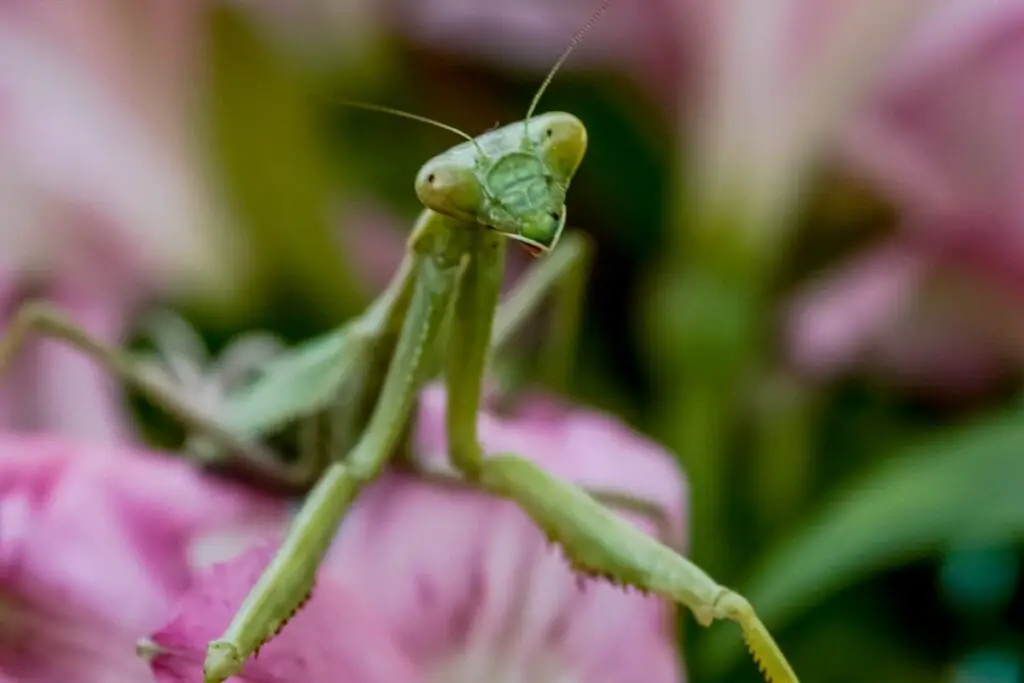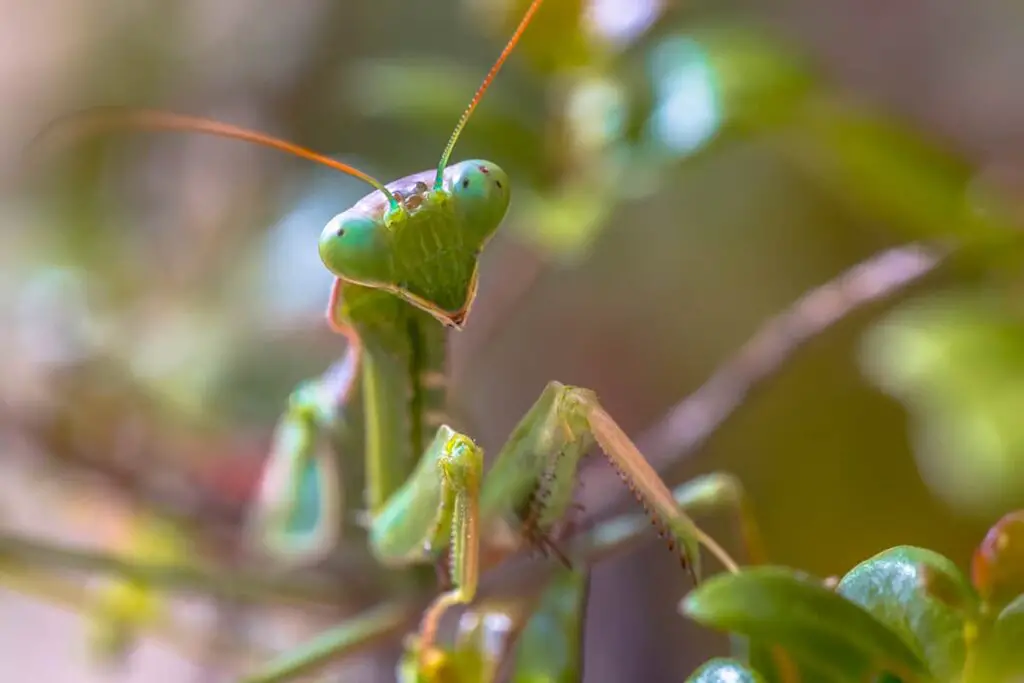Caring for a praying mantis requires understanding their natural habitat and replicating it to the best of your ability within your home. You want to ensure that your mantis feels at home, so providing the right mix of space, humidity, and temperature is essential for their well-being. Setting up a proper environment is not just about comfort; it is also critical for their health, growth, and molting process.
Your praying mantis will thrive in an enclosure that mimics their natural conditions; it should be spacious enough for them to move, climb, and hunt. An enclosure that is at least three times the length and twice the width of the mantis’s body ensures they have ample room, and the inclusion of a secure, screened lid is necessary for sufficient airflow. It’s also important to consider the lighting—bright and indirect light reflects their natural preference and keeps them healthy without the risk of overheating or dehydration.
Mantis Habitat Requirements
Creating a proper habitat for your praying mantis means focusing on tank setup, closely monitoring temperature and humidity, and providing appropriate lighting to mimic natural conditions.
Tank Setup
Your mantis requires enough space to move freely and exhibit natural behaviors. A general rule for enclosure size is that it should be at least three times longer than the body length of your mantis, allowing for ample climbing and molting space. The enclosure should include a suitable substrate and remember to choose materials that can maintain humidity without rotting.
- Size: At least 3x the length of mantis body
- Materials: Non-toxic, with ample climbable surfaces
- Substrate: Absorbent and easy to replace
Temperature and Humidity Control
A praying mantis thrives in an environment that closely mimics their natural habitat. Ideal temperatures range from 75 to 85 degrees Fahrenheit with moderate to high humidity, around 60%. It is important to maintain these conditions while avoiding extreme fluctuations to promote your mantis’s health. Use thermometers and hygrometers to monitor these parameters.
- Temperature: 75-85°F (Use a thermostat to regulate)
- Humidity: ~60% (Use a spray bottle or humidifier if needed)
Lighting and Photoperiod
Mantises are accustomed to natural light cycles, so your habitat must reflect a normal day-night rhythm. Bright, indirect natural light is beneficial but do not expose your mantis to direct sunlight as it can overheat the enclosure. You may use artificial lighting to simulate these conditions if necessary, like a low wattage UVB bulb, ensuring natural light exposure without harm to your mantis.
- Lighting: Bright, indirect or simulated natural light
- Photoperiod: Mimic natural day-night cycles
Maintaining these habitat requirements will help ensure that your praying mantis stays healthy and active, making for a more enjoyable and educational pet-keeping experience.
Mantis Diet and Feeding
Proper nutrition is crucial for your praying mantis’ health. Understanding what to feed them, how often, and the role of supplements ensures your mantis thrives.
Feeding Frequency
Your mantis should eat every 1 to 4 days, which varies based on their species, size, and life stage. Adult females, for example, often require more frequent feeding than males.
Types of Prey
Praying mantises are predatory insects that prefer live prey. Suitable food items include:
- Fruit flies for smaller or young mantises
- Crickets for larger mantises
- Moths and grasshoppers for variety
Always select prey that is appropriate for the size of your mantis.
Supplements and Water
While mantises typically don’t need supplements, occasional calcium dusting can be beneficial. Provide water by lightly misting the enclosure, ensuring droplets are available for your mantis to drink.
Mantis Health and Wellness
Maintaining your mantis’ health is crucial for its longevity and happiness. Focus on recognizing common health issues, understanding the molting process, and creating a stress-free environment to ensure your mantis thrives.
Common Health Issues
In your care, mantises may experience health problems such as dehydration, which presents as inactivity or refusal to eat. Another concern is fungal infections, often noticeable by a white fuzz on the mantis’ body. To prevent these, ensure that your mantis enjoys a properly humid habitat and regular monitoring for any signs of distress.
Molting Process
Molting is a critical growth phase for mantises. They require a vertical space to hang and shed their old exoskeleton properly. It’s vital that during molting, the enclosure has adequate humidity and is not disturbed to avoid complications like incomplete molting or deformities.
Stress Reduction
Stress can be detrimental to a mantis’ health. Keeping the enclosure in a quiet, low-traffic area helps, as does providing ample space for movement. It’s important to handle your mantis gently—if at all—since rough handling can cause unnecessary stress.
Handling and Interaction
In this section, you’ll discover how to develop a bond with your praying mantis through proper handling and provide stimulating environments.
Taming and Handling
When you first bring your mantis home, it’s essential to give it a few days to acclimate to its new environment before trying to handle it. Always approach your mantis gently and allow it to walk onto your hand willingly—never grab it. Handling should be kept to a minimum to prevent stress; short, infrequent sessions are best.
Environmental Enrichment
Providing environmental enrichment is key to a mantis’s wellbeing. Add varied perches, like twigs and branches, to give your mantis places to climb and hang, especially critical during molting. Introducing live prey at feeding time also serves as both nourishment and stimulation, encouraging your mantis’s natural hunting behaviors.
Frequently Asked Questions
Caring correctly for your mantis ensures a healthier and more active pet. Below you’ll find specific answers to common questions regarding mantis care to help you provide the best environment for your insect companion.
What is the ideal temperature and humidity for a mantis habitat?
Your mantis requires a warm and humid environment. Aim for temperatures between 75 and 80 degrees Fahrenheit and humidity levels between 60% and 70%. These conditions mimic their natural tropical habitat and can be critical for their health and wellbeing.
How should a terrarium for a praying mantis be set up?
A terrarium for a praying mantis should be at least three times taller than the length of the mantis and at least twice as wide as the mantis’s length. It’s important to include foliage and sticks for climbing and hiding, as well as a substrate with proper ventilation to prevent stagnant air.
What do I need to know before buying a praying mantis?
Before buying a praying mantis, know that their lifespan is typically around a year, and they can be solitary, so only one mantis per enclosure is recommended. Research the specific species to understand its size, diet, and environmental needs.
What are the basic care requirements for a praying mantis?
Basic care for a praying mantis includes maintaining appropriate temperature and humidity, providing a diet of live insects such as flies and crickets, and ensuring their habitat is clean with space to molt and hunt. Regular misting can help maintain humidity levels.
How often should I feed my praying mantis and what is their preferred diet?
Feed young mantis nymphs daily, and adults can be fed every other day. Praying mantises prefer live prey, such as flies, moths, or crickets, proportionate to their size. Feeding them appropriately-sized prey helps mimic their natural hunting behaviors.
How do I properly maintain the environment within a praying mantis enclosure?
To maintain the environment, clean the enclosure regularly to prevent mold and bacteria growth. Remove uneaten food and waste promptly. Monitor the humidity and temperature daily, adjusting as necessary to provide the optimal environment for your mantis.
Driven by a passion for those tiny creatures that rule our world, we at Bug Domain strive to be your go-to resource for information on insects.



